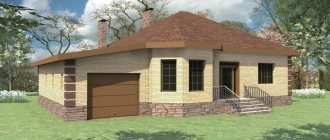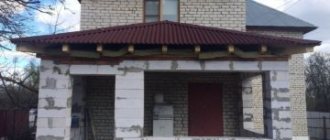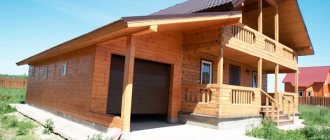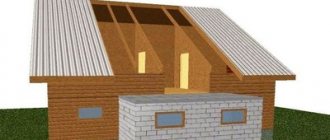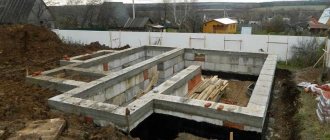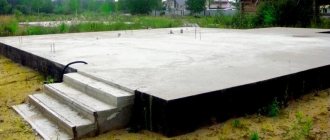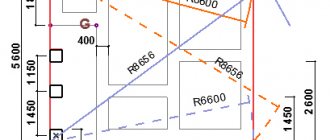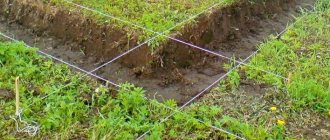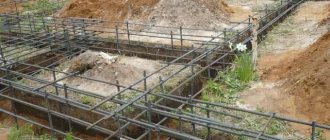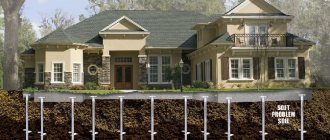The foundation for the extension must be securely connected to the existing foundation of the house. There are only two main options - either to connect the old and new foundations for the extension rigidly, using steel reinforcement as connections, or to use a simpler and less expensive connection of the foundation for the extension and the main foundation - by placing an expansion joint between them.
Construction of houses
More than half of the owners of country houses sooner or later face the need to expand the area of their home.
Naturally, this is easiest to do at the design stage of the building, but at this time, as always, the limited construction budget does not allow for a larger area. What should you do if you have received a residential building and want to build an extension to it? It is recommended to start with the most important stage - connecting a new foundation for an extension to the old one. Let's figure out what kind of foundation to pour for an extension, and how to properly combine the base of the house and the foundation of the attached module. Content:
The need to join two foundations
Home owners often have a need to increase their living space. A convenient and practical option for expanding real estate is to add block modules, such as a veranda. Such premises are open, so time can be spent here only during the warm season.
Before constructing the module, it is necessary to take into account that an extension to the house is possible only if a list of conditions is met: obtaining the appropriate permits for the construction of new structures, maintaining all permissible distances to neighboring houses and plots, ensuring independent settlement of all elements of the house relative to each other.
Like any construction process, the construction of a veranda should begin with the development of a project. This module near the house must be positioned in such a way that you can get from it into the main room, so it is customary to build a veranda at the end of the house or near the main entrance.
Despite the simplicity of the design, the extension must be completed efficiently and competently, and one of the first problems that arises with this is the installation of a foundation for the building. The best solution when constructing a foundation for an extension next to a house is considered to be combining foundations. Otherwise, cracks may appear in the walls, subsidence of the floor and other troubles may begin.
Features of connecting the old and new foundation
To understand how to properly build a foundation for an extension, you should find out how the foundation under the house is made and what it is like. If the foundation is strip, then you need to know its width; if it is columnar, then the overall dimensions of the pillars, as well as its depth. Experts strongly advise against building a foundation for the extension, which is distinguishable from the foundation of the house. Thus, if your house is located on a monolithic reinforced concrete strip, it is better not to save money and not build a columnar base for the extension.
The bottom line is that different types of foundations interact with soils differently, and accordingly, their shrinkage is different. Therefore, in order not to want to take risks, it is better to bet on the same grounds. The depth of the foundation of the extension must match the depth of the foundation for the house - this avoids distortions. Measuring the depth is quite simple. To measure the width, take a metal rod and bend it at a right angle.
After this, hold the bent part horizontally in your hand and thread it under the foundation. Turn it so that the hook hooks on the opposite side. Next, make a mark on the rod and remove it. You can use the serif to measure the width of the base. In addition, the foundation for the block module must be connected to the existing one, because otherwise the new walls will move away from the old building after some time. And this provokes the formation of cracks and distortions.
An important point that you need to pay attention to if you are going to connect the foundations together is that in the spring there will be a decrease in the bearing capacity of the soil. As a result, its humidity increases. A building built on a new foundation will experience additional shrinkage in the spring.
Considering the fact that old and new buildings may have a significant difference in weight, it is worth understanding that subsidence of the foundations will occur unevenly. Therefore, to connect the foundations between them, you should wait one season before work and provide for a technological gap. Such a gap, as a rule, is a gap that has a size of approximately 20 - 40 centimeters, in which pieces of reinforcing bars are placed that protrude from the foundations.
To expand the foundation, ordinary concrete mortar or reinforced concrete is used. In order for the old and new parts of the foundation to be firmly connected to each other and form a monolithic structure, before pouring the new foundation with concrete, it is necessary to strengthen the foundations: weld the reinforcement of these parts of the foundation or drill reinforcing bars into the old foundation.
Methods for connecting two foundations
The connection of two foundations can be carried out based on one of two solutions: constructing the foundation of the extension separately or rigidly combining it with the foundation of a residential building. When choosing a specific solution, it is recommended to take into account the severity of the attached module and the quality indicators of the soil on the site. If it is uniform, and the built house has not undergone significant shrinkage over time, you can combine the foundation of the building and the base of the extension into a single structure. Otherwise, you should think about building a separate foundation, which will be in contact with the base of the house through an expansion joint.
Rigid connection between the base of the house and the extension
When building a house with your own hands, the most difficult thing is to make a full-fledged rigid connection to create a single residential building-extension structure. As a rule, such a solution is relevant for a situation where the site has slightly heaving or non-heaving soil (when the settlement of the new foundation can be predicted), as well as in the case where it is planned to build a two- or more-story extension with a house under one roof. After the work is completed, a single design will be obtained.
The “tape-to-tape” connection between two strip foundations with your own hands is carried out in this way:
- First you need to dig out the foundation to the depth of the foundation of a residential building; the length of the trench should be about 1.5-2 meters. You should not dig up the entire side, but only part of it, while creating a sand cushion.
- Drill holes in the base of the house that have a diameter equal to the diameter of the reinforcement. For the middle part of the strip, a hole is drilled to a depth of ¾ of the width of the strip foundation in a checkerboard pattern and for the corner parts - to 0.5 meters.
- In the holes that are drilled ¾ of the width of the tape, you need to drive reinforcement with a longitudinal slot into which a wedging insert, for example, made of wood, is inserted. Drive 14 mm reinforcement with a periodic profile into the holes made half a meter long.
- Next, they are engaged in the formation of the frame of the future foundation, using the outlets of driven reinforcement as elements of the new foundation. To join the next parts of the base, releases are made that are 30-40 centimeters long, which are subsequently welded.
A rigid connection for an open contour is formed in a similar way, only the reinforcement is driven in slightly differently and more of it is used per unit area at the points of contact of the two bases.
A rigid “slab-to-slab” connection between a slab foundation and the base for an extension can be made if the foundation is thick (from 400 millimeters), or if there are slab protrusions at the base of the residential building from the base part. As a rule, such protrusions are left when constructing a foundation for a building made of aerated concrete. In this case, the base should protrude by at least 30 centimeters, which allows the slab reinforcement to be exposed and then welded to the frame of the new slab foundation.
If there is a large difference in the weight of the new and old buildings, for example, a light veranda is attached to the house, the level of their shrinkage will differ significantly. Therefore, it is not recommended to rigidly tie the foundations of these structures. In this case, you should pay attention to the construction of a separate foundation for the extension.
Separate base and expansion joint
The simplest and therefore most common option for laying a foundation for an extension is the construction of a separate foundation, which is located in close proximity to the base of the house. In this case, it is most reliable to work in a closed circuit, when you erect a full-fledged reinforced concrete grillage near the house. Between two foundations, waterproofing is carried out by laying sheets of roofing felt.
You can also use thermal insulation material or tow. The essence of the method is simple - to create a layer that allows the new base to play during settlement, without damaging the foundation of the house. When calculating the connection of foundations using an expansion joint, it is customary to focus on the indicators of the soil mixture, as well as the potential loads from the extension on the area under its base.
The calculation of the foundation is carried out in the same way as when constructing a deep or shallow strip foundation. Before making a foundation, you need to take into account an adjustment for future shrinkage, which is implemented by laying a new foundation slightly higher than the old one. The new structure will eventually settle to the depth of the foundation of the residential building. For the construction of a frame extension, a columnar foundation is used, due to the low weight of the structure.
Another option is to place the extension on a concrete pad. They are easily molded directly on site. Pre-impregnate the finished piles with mastic, waterproofing material or other impregnations for protection, after which they are installed in a mold and filled with concrete.
The pillars are spaced from each other at a distance of approximately 1 to 1.5 meters, depending on the overall dimensions and weight of the attached module. Determine the height at which you will place the floor, cut them to a certain size. Next, the building frame is attached to them. In just two days you can begin construction, which significantly reduces the work process.
Ideal option for connecting foundations
Already at the stage of building a house, you should think about the fact that after a certain time you will want to expand your home possessions. It is much easier to lay the foundation for an extension at this stage. This is the ideal foundation technology. This approach will allow you to create a rigid structure, and you will not have to think about expansion joints and other design solutions.
You can cover the area that is empty in the meantime with decking - temporary structures. This approach will do nothing to a well-waterproofed foundation. In addition, during this time the base will take the strongest position and reduce the risk of settlement during the construction of the above-ground part of the extension.
Thus, a situation often arises when an extension or a new building needs to be erected next to the house. When attaching a new foundation to an old one, it is necessary to give the new part time to harden well. Ideally, at least a year should pass from the stage of designing the foundation and laying it to erecting the walls. In this case, it is necessary to take into account factors such as the topography of the site, the type of soil, the weight of the structure and other features.
How to avoid mistakes
It just so happened that the Internet has become the main training ground for amateur builders who are looking for answers to all their burning questions on websites. In particular, some users are interested in: why does the earth shake after pouring? One can only guess what lies behind this question - but we think that the people asking it are faced with the phenomenon of frost heaving.
- It occurs due to differences in the volume of moisture present in the soil, which first turns into ice, reducing the volume, and then, increasing it again during the melting process, begins to displace solid particles. And it’s also good when thawing occurs only in the spring - otherwise in the southern regions the surface layers of the earth can freeze every night and thaw during the day.
- This phenomenon is very insidious and quite powerful; it is difficult and sometimes impossible to combat it after construction is completed. The soils that are most susceptible to heaving are those that are capable of swelling: silty clays and sandy loams. The problem is relevant not only for permafrost soils, but also for regions with seasonal freezing.
- The main signs of heaving are swelling of the soil from a minimum of 2 cm to half a meter. It is because of them that the earth “shakes,” which can lead not only to the appearance of cracks on the foundation, but also to its fracture. Is it surprising if the force of heaving can amount to tons? That is why it is so important to place the base of the foundation below the frost line, or to provide it with protection from heaving by installing anti-heaving layers.
- The smaller the area of contact between parts of the foundation and the soil, the less it is affected by heaving forces. In this regard, pile foundations are the most reliable, which is why in the north almost everything is built on them. In particular, not only strip structures, but also slab and glass (under columns) are supported on piles.
Foundation strips suffer the most in conditions of frost heaving: if you can still protect yourself from vertical heaving forces by digging below the UPG level, then there are also lateral forces acting tangentially. And the vertical surfaces of the tapes are large enough for the impact of lateral forces to be significant and there is a need for additional protection in the form of thermal insulation boards and wall drainage. As a result, a foundation of the “wall in the ground” type turns out to be too expensive.
Types of foundation for an extension to a house
Sooner or later, many country property owners decide to increase their living space by adding an extension to their house. In order for the connection of the main house with the extension to occur without problems, it is important to achieve a reliable and durable connection of the foundations. As practice shows, there are two main ways to attach the foundation of an extension to the existing foundation of a house:
- rigid connection using reinforcement;
- expansion joint.
Each of the options for connecting the main foundation to the base of the extension has its own characteristics and nuances that should be considered more thoroughly.
Necessary materials
Before arranging the foundation for an extension, you need to carefully prepare.
Study the initial parameters, create a project, calculate the estimate, prepare the necessary tools and materials:
- cement grade M300;
- sand for drainage;
- reinforcement rod with a diameter of 10 mm;
- boards for formwork;
- nails for fastening;
- gravel to create a pillow;
- rope and pegs for marking;
- wire for strapping.
Foundation with rigid connection of bases
Most often, a rigid connection between the foundation of the main building and the extension is used on soils that are not subject to heaving. Most often, this method is used in the process of low-rise construction in situations where the extension is functionally connected to an existing building and is located with it under a single roof.
To make a base for an extension, a special hole is drilled in it to a depth of about 35 cm. Its diameter should be equal to the diameter of the reinforcement that will be used for driving. If the construction of an extension is carried out according to a scheme that assumes the estimated length of the reinforcement is greater than the width of the foundation, holes in the base of an existing house are drilled only part of the width. The reinforcement is installed using the anchor principle.
If the contour is planned to be closed, the holes should be made at two levels and in a checkerboard pattern. As for the reinforcement, it must have an anchor wedge at one end and a welded washer at the other.
A rigid connection is also used in situations where the house has a recessed strip base, and the construction of the extension is planned from monolithic reinforced concrete.
A foundation with a rigid base can be available in two versions:
When installing such a foundation, the following list of works is expected to be performed:
- dig a trench, the depth of which corresponds to the existing foundation of the main building;
- fill the bottom of the trench with sand (create a sand cushion) and compact it;
- drill holes in the base;
- drive reinforcing bars with a longitudinal slot into pre-prepared holes;
- insert a wedging liner (for example, made of wood) into the reinforcement slot;
- drive the reinforcement into the holes in the corners of the base;
- form the frame using the remaining extract from the reinforcement that has already been driven in (for this purpose, parts with a length of 300 to 400 mm are specially left;
- after making the frame, fill the base tape with concrete;
- wait for the concrete to dry completely.
In order to attach a foundation to a house, you will need a whole list of equipment. First of all, we are talking about the following tools: a shovel, a building level, reinforcing bars, sand, wood inserts, a mixture of concrete and boards for making formwork.
Connection requirements
It is necessary to determine how to connect the new foundation of the extension with a residential building at the design stage, taking into account already existing factors. These include the following incoming conditions:
- type and design indicators of the foundation of the existing building;
- characteristics of underlying soils;
- time elapsed since the previous construction (the main shrinkage occurs in 1 - 2 years);
- commensurability of the weight load of 2 structures that need to be combined.
Full requirements for the calculation are contained in the set of rules SP 50-101-2004, which was developed in development of the regulatory rules contained in SNiP 2.02.01-83*, SNiP 3.02.01-87.
In any case, the help of experienced professionals is not superfluous, since mistakes can be costly later.
The result of linking the base and attached building structures with different values of foundation shrinkage is shown in this video. The construction of a new building begins depending on the season. In the spring, it is not recommended to start laying next to existing foundations, since at this time of year the soils are in the most loose and water-logged state. The settlement value of a new extension on heaving soil may be much greater than the calculated value in the project and may be uneven around the perimeter. At the same time, there is a risk of movement of the undermined old support due to the high groundwater level in combination with possible precipitation (rain or snow).
Before starting work, it is necessary to take into account that any new foundation (MZLF, piles, pillars, slab) will certainly settle, even if it is made identical to the existing support.
Shrinkage
In construction, there are established settlement standards for various structures, the foundations of which are designed and manufactured in accordance with current state standards.
You can find out the standard and make a forecast for the design of your individual home using data from the reference tables:
When comparing the calculated indicators, a new support unit is attached to the foundation of the old building at a given depth, taking into account its own settlement after a certain time.
Monolithic soles vary in height
The upper marks of monolithic strip foundations of combined buildings are made according to calculation, and not according to level, as in this photo.
It is the possibility of displacement relative to each other that determines what kind of connection between two foundations can be made. The following types of connections are used:
- Rigid bond (concrete with reinforcement).
- Separate installation (installation of an expansion joint taking into account the mutual influence of the supports).
The possibility of a rigid connection into a single structure is significantly influenced by the geological factors of the site - in case of mobile or heterogeneous soils, for buildings with a large support area, it is necessary to make intermittent foundations (sometimes with different widths of the tape).
Starting the independent construction of a new extension module to a residential building is permissible if the following requirements are met: issue permits for the installation of a new structure, maintain distances no closer than the minimum permissible to nearby buildings and communications, ensure independent settlement of all structures in relation to each other.
Combining foundations
It is best to attach a new room to the existing foundation of the house using a rigid coupling. In this case (if all conditions are correctly taken into account), it is possible to connect the above-ground surfaces into a single whole without the expectation that gaps and distortions will appear between the elements and the floor level. But such a design solution is limited to sites with non-heaving soils that have high load-bearing characteristics.
Old foundation needs strengthening
In practice, this method is used for low-rise buildings, provided that the extension being built is functionally connected by one roof to the building that is already in use.
Another condition for unification is the same type of foundation. If the strip base of a residential building turns out to be insufficiently wide, then it needs to be strengthened.
Such work includes connecting the reinforcement of an old support with a new frame or laying connecting anchors by drilling, followed by filling the belt with branded concrete. The reinforcement belt prepared for applying the solution is shown in this photo.
The connection of buildings consisting of several floors is carried out according to a more complex scheme, which involves the construction of covering walls with dividing seams on each side, as shown in the drawing.
The rigid type of connection is chosen for cases when the problem of how to connect an old established foundation with a new building is considered, for buried strip foundations. The extension is also designed with a monolithic reinforced concrete structure.
Strip foundations
For a permanent building attached to a house, with a commensurate weight of the building materials used, a stable support of a large area and load-bearing capacity is necessary. This request corresponds in most cases to a strip foundation.
- Expose the entire depth of the existing tape. You need to dig a trench in parts (1.5 m - 2 m), not along the entire length at the same time, since the exposed part loses lateral support, which can lead to its deformation. An old building can be further strengthened with inclined supports.
- Drill holes along the side of the connection corresponding to the size of the reinforcement Ø. In the middle of the tape, holes are drilled in a checkerboard pattern with a depth of about 0.75 of the width of the foundation itself, in the corners - 0.5 m. Reinforcement is driven into the middle holes, in which longitudinal slots are made with an inserted wedging liner for strong fastening in the hole. Reinforcement Ø 14 mm, having a periodic profile, is driven into the corner holes. The output of rods must be at least 0.3 - 0.4 m.
- The frame of the new foundation is knitted and welded to the released reinforcement.
- Fill with concrete mortar.
Open loop with supports inside
If there is access to the subfloor for work, the holes for pin-type tension elements can be made through, with the rods secured by flat plates.
Rigid connections of tapes in the form of an open contour (U-shaped) are made in the same way, but the reinforcement is placed in rows with smaller spacing. If the connection side is long in the open strip, you can make several additional support points different from the monolith, as can be seen in the photo.
If there is a need to change the depth of support on the soil of the foundation being added, it is filled with ledges, the height of which varies in steps of no more than 0.5 m. The first ledge is located at a distance of about 1 m from the old foundation. The connection is made with a reinforced concrete strip of the same thickness as the existing foundation of the house.
Each option for rigid connection of foundations has its own characteristics for specific cases, which it is advisable to entrust to professionals to consider and calculate.
Plates
It is possible to ensure the rigidity of the connection between the slab foundations of the house and the extension provided that they are sufficiently thick, about 0.4 m, and also if the old slab protrudes beyond the boundaries of the supporting walls of the building. Such protrusions are usually left during the construction of aerated concrete cottages. The outlet dimensions must be at least 0.3 m. This will make it possible to clean the reinforcing mesh of the slab and make a welded connection to the frame of the new extension.
The connection of monolithic bases is carried out according to the following scheme:
The slab of the old house, which has already settled, in this case not only becomes one with the new fill, but also receives additional reinforcement in the vertical connection of cement mortars due to 0.2 m - 0.3 m of fill underneath it.
Foundation with expansion joint
An extension to a house with a foundation with an expansion joint is most often used in industrial and multi-story construction. That is, where the soils under the structure can differ significantly in their deformation properties. For example, quite often an extension of another number of storeys is connected to an existing house of one storey by laying a foundation with an expansion joint.
In any case, an expansion joint must be provided at the construction design stage.
At its core, any expansion joint, through which a foundation for another building is connected to a house, is insulation in the gap between the basement floors and the walls. Often, ordinary tow is used as this insulation. The place where the connection to the house is made is fenced off with a special decorative overlay, which is attached to the house wall.
When building a house on heaving soil, experts recommend making the floor level of the extension lower than the floor level of the main structure. The magnitude of the difference must correspond to the expected deformation.
To attach a foundation to an existing house using an expansion joint, the following significant points should be taken into account:
- Leave a small gap between the main house and the foundation of the extension (no more than 5 cm). In order to comply with this requirement, before starting to lay the foundation, you should attach boards pre-treated with waterproofing material to the foundation of the house. In the future, it is they who will perform the function of an expansion joint assigned to them.
- In single-story construction, the thickness of the expansion joint can be no more than 2 cm.
- If desired, the expansion joint can be filled with any heat-insulating material. Most often, penoplex and polystyrene foam are used for this purpose. From the outside, everything is covered with a decorative overlay.
If the main purpose of an extension to an existing house is to form a separate zone, and not to expand an existing premises, a rigid connection of two foundations between one house and another should not be done in any case, since the consequences may be the most undesirable. In this situation, it is much more advisable to use an expansion joint.
If we are talking about a small extension, it can be built on a shallow strip foundation or a foundation on stilts.
Peculiarities
The difficulty when adding additional premises is the presence of a ready-made old building, which has already undergone shrinkage and has certain defects and design features. All these points should be taken into account when designing an extension. It is necessary not only to build a room that is durable and harmoniously suited to the rest of the ensemble, but also not to harm the finished house or contribute to its deformation or destruction. Errors and miscalculations in the design and arrangement of the foundation are unacceptable; they lead to serious consequences and problems for the entire building.
It is very important to make a strong connection between the new and old foundations.
There are two ways to connect bases.
- The expansion joint is simple to make, suitable for all types of foundations, and less expensive. In this case, both foundations are independent of each other under shrinkage or deformation loads. A layer of waterproofing and thermal insulation is laid between the main structure and the attached one, and an expansion joint is formed. The roof of the extension with this method must be separate.
- Rigid reinforcement is more reliable and durable; it is used for old buildings that have completely undergone shrinkage, over 15 years old, in the presence of a high-quality foundation. The connection is made using metal reinforcement. If a new and already finished building is planned to be combined under one common roof, then the connection must be made rigid. The only obstacle to using this method is heaving soils.
When building extensions for various purposes, it is worth taking into account the design features, soil properties, and the type of foundation of the old house. Different types of foundations are used, which differ in execution technology and technical characteristics. It is recommended to choose the same type of foundation for a new room as for an already built house. Too different characteristics can lead to different subsidence, deformation and even collapse of the entire building.
The strip foundation will support both a light veranda and a heavy structure. To evenly distribute loads and avoid deformations, the strip base must be a closed loop.
Columnar foundations are used in the construction of lightweight structures ; they are affordable and easy to implement. Vertical pillars are located at a distance of 1.5–3 meters from each other. The material used in the pillar method is brick or reinforced concrete. Larch timber is used less often, as it is expensive and rots over time. Despite the grillage, the columnar base is unstable. When constructing a columnar foundation, you cannot dig a basement, which is the only disadvantage of this simple and reliable foundation.
Screw piles, united by reinforcement or an additional tape contour, have a high load-bearing capacity and can withstand heavy capital structures. They are made from reinforced concrete, steel, asbestos or wood. The piles rest on deep load-bearing layers of soil, so they are not subject to displacement or deformation due to heaving. This foundation will not sag.
TISE technology has a number of advantages. It is similar to the construction of a pile foundation due to high reinforced concrete grillages. But there are also disadvantages.
This is a new technology that is still being studied in the long term, but is already quite popular among builders due to its availability and versatility.
The piles are equipped with a special extension at the end, the so-called heel. It prevents the piles from rising during soil heaving and allows construction to be carried out in conditions of permafrost and increased seismic activity.
If the main house stands on a floating slab, then it is necessary to attach a new room on the same independent slab, laying an expansion joint between them.
A rigid connection is possible if the thickness of the slab is more than 400 mm , or the slab protrudes beyond the base by at least 300 mm; in this case, the reinforcement is exposed with partial destruction of the concrete and welded to the reinforcement of the new base. The monolithic slab is durable and will perfectly withstand the heaviest buildings even on difficult soils.
Choosing the type of foundation for an extension
Experienced specialists strongly recommend that for the construction of an extension, use the same type of foundation that was used for the construction of the main building . This is due to the fact that different foundations react differently to contact with the soil and also react differently to shrinkage of the building.
Accordingly, if the main house is built on a strip foundation, and the extension is built on columnar piles, sooner or later the auxiliary structure will collapse. Thus, you should not skimp on things like connecting foundations under any circumstances.
If you plan to connect the building to the house, you can use different foundations. Most often we are talking about the following options:
Strip foundation
For those who decide to use a strip foundation for the extension, the following list of work will be required:
- make markings in parallel with the tracing at the site of construction of the base structure (this will require wooden pegs and an ordinary rope);
- dig a trench along the marking;
- secure the fittings;
- prepare a trench;
- fill in a sand cushion (approximately 100-120 mm) and carefully compact the bottom of the trench;
- lay a waterproofing film;
- install reinforcement structure;
- Fill the trench with a solution of cement and gravel.
The pouring of a strip foundation should be approached as responsibly as possible. It is better to do the work in several passes. One third of the trench is poured as the first layer, and after drying - one second. The technology, in principle, allows the use of foam blocks, but not in all cases.
After the cement-gravel layer has completely dried, the formwork is built. The formwork is filled to the brim with concrete. After laying, the concrete is pierced simultaneously in several places. This prevents the formation of air bubbles. After the concrete has completely dried, the formwork is removed.
And finally, just before the walls are erected, the almost complete structure is covered with a layer of waterproofing material. Most often, roofing felt, tar, liquid rubber or bitumen mastic are used for this purpose.
Columnar foundation
If your plans include building a house that is small in size and light in weight, the use of a columnar foundation is quite acceptable. It is usually made of either concrete or brick. For a medium-sized building, 6 support pillars are most often sufficient.
To install such a base you will need:
- dig a hole (depth below the soil freezing level);
- pour a sand cushion on the bottom;
- install metal (or fiberglass) fittings;
- treat the reinforcement with moisture-proofing material (for metal reinforcing bars);
- install formwork;
- fill the base with concrete.
Construction can begin immediately after the concrete has hardened. If there is a need to increase the height of the pillars, you can lay a brick on top of the concrete.
Foundation on screw piles
A foundation on screw piles is the simplest and most cost-effective type of foundation. Please understand that it is only designed for structures that are not too heavy, as it cannot support much weight. But if you are going to add a wooden veranda to your house, this option is quite suitable.
This type of foundation in most cases does not require the participation of specialists. Even a person who has no experience in construction is quite capable of screwing in screw piles with his own hands. It is probably for this reason that many people choose a foundation on screw piles.
If the foundation on stilts is installed correctly, it can last for a long period of time.
But no matter what foundation needs to be installed, on screw piles, columnar or some other, the most important thing is that all work is carried out in accordance with the technology. Therefore, if you do not have enough construction experience, it would be most advisable to entrust the pouring of the foundation to experienced and qualified specialists.
Pile foundation construction technology
The first step is to choose a veranda project and draw its plan, deciding on the exact dimensions. After drawing up the drawing, you can already calculate the amount and weight of materials needed to mount the piles. You should also take into account the quality of the soil and the depth of water, the level of soil freezing. After this, you need to select the correct parameters and number of pile pipes, taking into account that their distance from each other can be 1.5–3 m.
The easiest way is to build an open veranda from wooden beams with your own hands. Snow loads by region can be found in the Building Code under Loads and Impacts. For example, in St. Petersburg, for every 1 m² of roof there is up to 180 kg of snow mass.
Required materials and tools
When constructing a summer veranda on a pile-screw foundation, you need to purchase the following materials:
- sand;
- crushed stone;
- cement;
- screw piles;
- wooden beams for joists and roof (100×50 mm);
- beams for grillage (metal, concrete or wood);
- boards;
- nails, screws;
- varnish or paint for wood;
- roofing material (selected in accordance with the roof of the main building).
For a light wooden veranda, it is better to use a profiled crown beam with a cross-section of at least 150×150 mm as a grillage. In addition to the above materials, it is necessary to treat the piles with anti-corrosion agents, for example, bitumen.
You should stock up on the following tools:
- shovel;
- collar for twisting;
- welding machine;
- deep compactor for concrete mixture;
- an angle grinder with cutting wheels (grinder);
- hammer;
- saw;
- screwdriver;
- tape measure;
- plumb line;
- level (regular and hydraulic);
- pegs and rope.
Gates for manual screwing are sold already with rods.
Preparatory work
First you need to clear the area where the extension is planned. Then you need to dismantle the porch and blind area. The soil under the screw foundation can simply be leveled with a shovel. After this, using pegs and rope, mark the perimeter of the veranda. Next, the installation sites for the piles are marked and small holes are dug in them for ease of screwing.
How to screw in screw piles
The procedure for installing screw piles is as follows:
- The rod tube is inserted into the hole with a blade and screwed in with a collar. It is best when this procedure is performed by two people. At the beginning of screwing in, it is necessary to constantly check the vertical position of the piles with a plumb line and correct it if necessary. If there is a slight deviation, the piles are cut, making the ends level. Usually 20–30 cm of pipe is left on the surface (depending on the height of the base).
- When all the piles are installed at the required depth, marks for the grillage are made using a hydraulic level at the above-ground ends.
- The rods are cut with an angle grinder at the marked level.
- Concrete is poured into the pile cavities and immediately compacted with a compactor.
- A steel rod is inserted into the middle of the cement mixture (this is necessary for a veranda with a wooden grillage). Then the lower crown beam is attached to it.
- The pipe is covered with a head and welded.
- Waterproofing is attached to the top.
When determining the parameters of the veranda adjacent to the wall of the house, a line is drawn. When applying it, take into account the thickness of the lumber that is laid on top.
Installation of grillage and floor
Along the boundaries of the extension, a crown beam is laid on the piles. If the veranda is of significant size, then the beams are hammered inside the perimeter and then tied. There, using a corner and screws, the logs are attached at intervals of 50–60 cm around the perimeter of the structure. At the bottom you can make a base from siding or slabs. Then vertical posts are installed in the corners, to which the canopy or roof will be attached. A flooring is made from boards across the joists. It is recommended to fill the voids between them with gravel.
Lastly, install the veranda fencing
Its foundation may settle slightly, so the structure must be independent. A gap of 2-3 cm is made between the veranda and the wall, which is filled with insulation (for example, mineral wool). A foundation made of screw piles for the veranda of a private house can be installed independently, without carrying out excavation work and waiting for the concrete to harden. This significantly reduces the time and finances for constructing an extension.
How to properly connect the foundation of an extension to a house
Usually, when planning a future home, owners try to think through the layout so that they don’t have to finish building anything later. But sometimes there is a need to increase the area, add living rooms, a veranda or utility rooms. A reliable structure is required, with walls that do not move away. To do this, the foundation for an extension to the house must be correctly tied to the main foundation.
Foundation for extension
What you need to pay attention to:
- Foundation type.
- Land quality.
- Was the imported soil added?
The required information can be found in the project documents. If they are not preserved, you will have to dig a small hole near the foundation. After which you can determine its design features. When excavating a pit, it is necessary to take soil samples to study their characteristics.
Functional
As with the construction of a house, before constructing an extension it is necessary to determine the functionality in advance, since different purposes require appropriate construction manipulations. If you plan to make living rooms, enhanced insulation is necessary. Communications are immediately laid out for the boiler room, bathroom or kitchen. It’s easier to change your mind and plug a couple of plastic pipes into the wall than to decide that another bathroom is more necessary and dig into a newly built one.
Why does deformation occur?
Deformation during foundation shrinkage
Different foundations behave differently when in contact with soils susceptible to heaving. Therefore, if the base is strip, then the new one should be the same. Another important rule: you cannot lower the new foundation below the main one.
How to determine the width of the sole of the strip base:
- You need to take a metal rod, the end of which is bent at a right angle.
- We push the rod under the structure so that the hook is positioned horizontally.
- After the rod passes the base, we unfold it so that the hook is positioned vertically, with the tip up.
- Pull the rod towards you until it stops.
- Let's make a mark.
- Unfold and pull out the rod.
- The segment from the mark to the fold is equal to the width of the sole.
Reasons for shrinkage of the extension:
- The main building has usually already settled down, but the new extension is just beginning to sink.
- Part of the attached foundation rests on imported soil, and part on “native” soil. This leads to complex deformation displacements, causing the formation of cracks in the most unpredictable places.
The consequences of natural shrinkage can be minimized by extending the construction period. To do this, we allow the foundation to stand for at least one season. The extra weight will cause some shrinkage, but not as much.
How to tie a foundation
There are mainly two pairing methods used:
- Using a reinforced rigid connection.
- Using an expansion joint. This is a simpler and more economical way.
Hard docking
Rigid connection using reinforcement
This type of connection is used in soils that are not subject to heaving. It is better not to use it in areas with other soil. The foundation of the extension must be laid to the same depth as the rest of the structure. Otherwise, the likelihood of cracks increases.
Work order:
- We drill holes in the main foundation. They are intended for reinforcing material. The depth of the hole is the diameter of the reinforcement multiplied by 35. For example, the frame is made of reinforcement with a cross-section of 0.8 cm, which means you need to drill holes 28 cm deep (35x0.8).
- We dig trenches under the foundation of the extension.
- We drive in the reinforcement.
- We install formwork panels.
- We assemble the reinforcement frame.
- Pour the concrete mixture.
Connection using an expansion joint
An isolated foundation is being erected near the old building. The gap between the two structures is 50 mm. To install it, before starting pouring, we lay boards wrapped with any available waterproofing material close to the main structure. The boards can not be removed after pouring.
An expansion joint connects the partition between the wall of the house and the extension. The empty space is filled with elastic materials (mineral wool, etc.). Then it is sealed with special sealants that are resistant to moisture. It is advisable to fill the seam as the walls are built.
The construction of an extension requires the same serious attitude as the main building. Therefore, the foundation must be designed to withstand future loads. It is necessary to take care of full reinforcement, insulation of the base and proper pouring of concrete.
Construction of a foundation for an extension to a house
Foundation selection basics
It is not recommended to build a superstructure without an exact connection with the existing foundation, so as not to cause distortion and further destruction of the structures. Therefore, the foundation for an extension to a house is selected strictly according to the type of future development and the already built structure.
When a building is designed and regardless of the type of foundation, be it prefabricated strip or columnar, the superstructure is done without additional problems. In this case, a minimum of building materials and structures will be used, the connection will be rigid, and the mass transfer will be uniform.
With an already constructed building, everything will be more complicated, especially if the design of the foundation and its condition are unknown. It is recommended to conduct detailed geodetic studies of the condition of the soil, the foundation itself, and only then select the optimal type of foundation.
Construction of an extension to the house
Design and construction of the foundation simultaneously for an extension and an existing building. In this case, the foundation for the extension to the building and the main frame are connected, since a single reinforced structure is formed. It is worth considering that it is difficult to foresee the possibility of an extension in advance, and it is quite difficult to make an extension to a wooden house without damaging the frame.
It is possible to add additional premises to an existing building. In such cases, it is necessary to ensure the most rigid and high-quality connection between the existing foundation and the future one, so that the resulting structure is a single whole. It is important to take into account the presence of elevation differences at the construction site.
Before pouring the foundation for an extension to the house, you must:
- determine the type of existing foundation of the house, the maximum permissible loads, the characteristics of the columnar foundation, as well as the width of the tape;
- soil type, its characteristics, freezing depth, groundwater level and other soil parameters.
Regardless of the extension option, in any case it is necessary to make a preliminary calculation of the permissible load on the foundation, as well as analyze the condition of the soil, since it is necessary to connect two independent foundations to each other. If a wooden structure is being built, then the bond may be minimal, but in the case of a brick house, the bond is made more powerful. Next is the marking
Video about marking the base before pouring
Extension on stilts
Light buildings, regardless of the nature of the base of the main building, can be erected on stilts. Various combinations and options for junction points are possible:
- Tape - piles. It is impossible to rigidly connect a “hanging” grillage to a monolithic structure, and the abutments of the facades are separated by a “warm” expansion joint.
- Piles - piles. For example, this is a common type of foundation for a foam block or frame house. Technically, grillages can be rigidly tied under the “boxes” of buildings. With wooden beams and metal profiles there are no problems with tying. And reinforced concrete beams can be tied together with reinforcement bars if their thickness allows holes to be drilled.
Determination of the characteristics of the base
In some cases, especially if the extension will be connected to an existing building, the type of foundation cannot be determined, because there is no technical documentation for the development, or private developers built the house themselves. Accordingly, it is necessary to determine the current state of the foundation of an existing structure:
- first excavate the soil to a depth below the base of the foundation;
- determine the type and dimensions;
- calculate the load of the house on the ground;
- conduct a soil analysis, calculate the maximum permissible parameters of soil resistance at the site of construction of the extension.
How to calculate the reliability of an existing foundation? Foundation reliability is a key factor for both existing and future foundations . It largely depends on the type of soil, the depth of soil freezing, its heaving, and the mass of the building.
The design of a strip recessed foundation built on heaving soils is considered reliable if, when calculating the dimensions of the sole, values such as the load of the house and the resistance of the soil itself under the sole are taken into account. And when the heaving deformation of the base under the influence of vertical and horizontal ground forces at the moment of freezing is approximately or equal to zero.
Shallow foundations are reliable if the support parameters are calculated taking into account the load of the structure and the resistance of the sand and gravel cushion, soil freezing does not lead to deformation of the structure and heaving deformation is within normal limits.
The connection of the foundation of buildings to an existing house is carried out by a rigid connection of two foundations and a flexible expansion joint.
Useful tips from the pros
To avoid mistakes and build a strong and reliable extension, you can use the recommendations of experienced builders and get an excellent and durable result.
- Soil analysis will allow you to correctly assess loads and predict soil heaving and shrinkage of the structure being built. The choice of base type is influenced by the groundwater level and freezing depth.
- In a pillar foundation, despite the strapping, there is instability to loads, so the correct solution would be a technological seam, and not a rigid bond.
- According to building regulations, the minimum distance between piles with a screw base is 1 m, and when using bored piles it is three diameters. The distance from the finished strip or slab foundation to the nearest pile must be at least 30 cm.
- If a common roof is planned for both parts, then a rigid connection of foundations is required. If an expansion joint is made between the foundations, then the roof must be independent.
- The width of the trench should be 30 cm greater than the width of the walls, to take into account the width of the formwork boards, and the depth on sandy soils should be at least 30 cm, on clay soils - 1 m.
- The columnar base must be waterproofed by wrapping the pillars with roofing material under the base and on the sides. It is possible to use ready-made FBS blocks.
To learn how to make a foundation for an extension with your own hands, watch the video below.
Application of rigid connection
When constructing brick or concrete extensions, a rigid connection is practiced, where the mass of the structure per unit area is high. This connection is not used for wooden houses. A rigid connection means that the extension is connected to the house by existing partitions, ceilings or roof.
To make the base, you need to drill a hole with a diameter of a reinforcing bar and ensure a immersion depth of about 1 meter. Then reinforcement is driven into the hole, connected with anchors or welding and fixed with concrete mortar.
With a closed contour of the structure without visible or load-bearing elements of the reinforcing belt, holes must be drilled in a checkerboard pattern. The required amount of reinforcement, drilling interval and method of connecting the rods is calculated individually.
For a wooden house, less reinforcement is used due to the low mass of the house, for brick houses - several times more. On average, a closed loop needs reinforcement at the rate of 20 rods with a diameter of up to 9 mm per 1 m². For an open contour, the calculation of the amount of reinforcement is carried out individually.
Selection for different buildings
To choose the right type of foundation for an extension, you should first study the condition and dimensions of the foundation of the main building and the type of soil. You can do this yourself. To do this, next to the old house you need to dig a pit with dimensions of 100x150 cm. In a columnar foundation, the depth of the piles and their dimensions are measured, in a strip foundation - the width of the base and height.
This will ensure equal conditions for shrinkage and give greater strength to the entire bond.
For lightweight frame extensions to a wooden house, a budget option with a columnar base will be sufficient. This base is suitable for all light types of verandas, terraces, porches, dressing rooms and vestibules. The depth of the new and old foundation should be equal. On swampy soils with a high groundwater level, you should choose a pile or columnar foundation.
Brick houses most often have a strip foundation, so it is also recommended to add a strip foundation. Several types of ligaments are made between the bases.
- Rigid connection of bases with a closed loop. For such a bundle, you need to drill holes in the finished tape to a depth equal to 35 diameters of the connecting reinforcement. They are arranged in a checkerboard pattern in two layers, then rods 70-100 cm long are inserted into the holes. You can secure the reinforcement in the old foundation using the wedging method, when notches are made at the end and when driven into concrete, wedging occurs, or you can use a chemical anchor. Then the new reinforcement cage is tied with rods.
- If a new foundation is planned with an open contour, then a rigid connection is made only at the joints with the existing foundation.
- The technological seam with a closed tape contour is made from sheets of polystyrene foam 5 cm thick, which is laid between two bases and at the same time is a vertical element of permanent formwork.
- An open circuit with a technological seam is arranged according to the above scheme, only the insulation is placed at the junction of the circuits.
Foam concrete has low shrinkage rates and is light weight; you can build the walls of an extension from it on your own without the involvement of experienced builders.
If the house has a basement and several floors, the walls of the building are wider than 40 cm, the soil is complex and large loads are planned, the best option would be a slab base in which the loads are distributed over the entire area.
Expansion joints
When constructing extensions to large buildings for various purposes and in the presence of different soil structures under the foundation strip, expansion joints are used. Therefore, the soils themselves have different resistance and the load on the soil in different places of the foundation is different.
Seams are always used at various heights and levels of the building in order to maximally neutralize the resulting loads, and seams are often made at the level of the base or plinth, connecting the different tiers of foundations.
Expansion joints are insulation installed in the gap between the wall and the base; there is no provision for a rigid connection to the frame. Often tow or polyethylene cord is used as insulation, less often polypropylene, polyurethane or polystyrene foam.
- The gap between the future and existing buildings must be at least 5 cm. To create the necessary gap, use boards, plastic or slabs covered with waterproofing. This will be the expansion joint in the future.
- For small wooden buildings, it is enough to make a gap of up to 2 cm, for brick and concrete - from 5-10 cm.
The seams can also be filled with sealant or foam, and the surface can be coated with protective compounds that are resistant to weathering.
Recommendations for constructing a foundation for an extension to a house
If the extension needs to create a completely individual recreation or living area, then the foundation will have to be poured separately, and the walls will be connected to each other using an expansion joint. Don't forget about markings.
It is better to pour strip foundations in the fall, and do all preparatory construction work in the spring.
Wooden extensions can be erected on a shallow strip or pile-grillage foundation.
Thus, only the correct choice of foundation type and ensuring reliable connection of the foundations can ensure the necessary reliability of the extension to the existing house. A rigid ligament is more expensive than an expansion suture, but the advantages of the suture are undeniable. But you shouldn’t choose the connection method yourself, especially if the building is already quite old.
